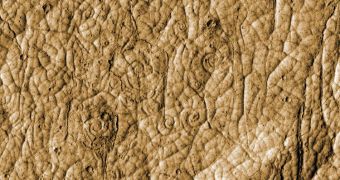A paper published in the April 27 issue of the top journal Science suggests that once-active volcanoes played a central role in the formation of a network of valleys on the Martian surface that previously defied explanation. The results came from a new analysis of giant lava coils on the planet's surface.
The Athabasca Valles region, which lies near the equator, was of special interest to investigators. The origins of this landscape feature have puzzled geologists and planetary scientists for a long time, and the new study finally provides a plausible explanation for how it appeared.
In the past, some experts argued that dry ice (frozen carbon dioxide) or water ice was responsible for creating the area, through glacial erosion. The idea that lava was responsible for this process was also put forth some time ago, but with few evidences to support it.
An interesting aspect of these studies was that researchers tended to agree on the fact that either fire or ice must have been responsible for generating the Athabasca Valles. The entire region is covered in a weird pattern of multi-sided polygons, Space reports.
Investigators argued that such surface crack patterns might have arisen as the result of seasonal temperature fluctuations over an ice-rich environment or over an area covered with cooling lava.
But ice-related activity cannot explain the 269 lava spirals that a recent analysis of the region revealed. High-resolution images collected by the NASA Mars Reconnaissance Orbiter (MRO) identified these structures with precision, not leaving much room for alternative interpretations.
“This is the first time lava coils have been identified on an extraterrestrial setting. The most surprising thing about these features when I first saw them was how well-preserved they are,” says the lead author of the Science paper, Arizona State University (ASU) expert Andrew Ryan.
This is surprising also because several other regions of Mars have been recently shown to be extremely prone to suffering changes over short time frames – as little as a full Martian year. However, the lava cracks must be at least several hundred million years old.
“You can't see them unless you zoom in really close, and even then they're really subtle – it's pretty dusty there, so the images are just a pale gray color, and they don't really jump out until you boost the contrast, so it's not surprising at all to me that they've been overlooked before,” Ryan concludes.

 14 DAY TRIAL //
14 DAY TRIAL //